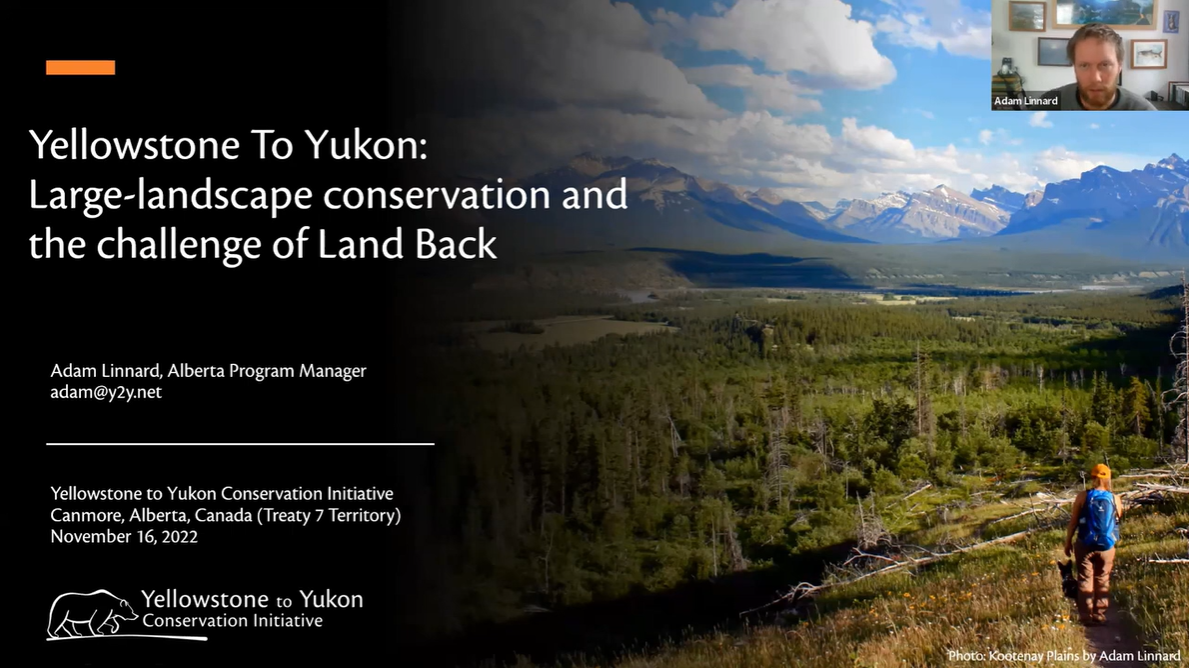Global Change Seminar Summary: Indigenous Leadership in Conservation from Yellowstone to Yukon

This post was written by 2022-23 Global Change Fellow Christina Perella, summarizing the second webinar in the Fall Global Change Seminar Series, Indigenous Leadership in Conservation from Yellowstone to Yukon, on Nov. 16, 2022. The panel was moderated by Global Change Fellow, Julianne Reas. The seminar planning team also included Austin Lamica, Samantha Michlowitz, Graiven Ulate Ramirez, Erin Eichenberger, and Murry Burgess.
View a recording of the seminar.
As land-use and climate increasingly fragment and threaten the stability of wildlife habitat, conservation organizations are prioritizing the creation and management of a connected network of healthy land and waterways. One such organization is the Yellowstone to Yukon Conservation Initiative (Y2Y), a transboundary organization with a mission to protect and maintain connectivity among the critical habitat from Yellowstone to Yukon. To successfully connect habitats from local to landscape scale over this large region, Y2Y collaborates with partners and community groups across many jurisdictions, including support for Indigenous leadership in conservation and greater sovereignty in land management decisions. To learn more about these initiatives and some of the projects being led by Indigenous people in the Y2Y region, the Global Change Fellows organized a seminar with the following panelists:
- Adam Linnard: Yellowstone to Yukon’s Alberta Program Manager
- Matoomiikamoosaaki (First Steals Woman) / Latasha Calf Robe (english name): Member of the Kainaiwa First Nation and founder of the Niitsítapi Water Protectors
- Elliot Fox: Member of the Kainai First Nation and Indigenous Consultant and Assistant Project Manager of the Blackfoot Confederacy Native Trout Recovery Project
As Alberta’s program manager, Adam Linnard guides campaigns to connect and protect habitat so that both people and nature can thrive. He began his presentation with an introduction to Y2Y, describes the scientific underpinnings of large landscape conservation and the Y2Y vision, and ends with some of the questions and lessons arising for large landscape conservation from growing Indigenous sovereignty or Land Back movements. Linnard discussed the scale of large landscape conservation and the idea that this scale comes directly from the needs of species like grizzly bears, wolves, and caribou which are native to the region. Learning from the success of Y2Y in terms of wildlife habitat, he looked towards the future and highlighted the importance and implications of Indigenous rights and sovereignty for large-landscape conservation, as well as the need to understand our role as we build relationships across differences.
Latasha Calf Robe, who has a background in social innovation and systems change theory, founded Niitsítapi Water Protectors (NWP), a grassroots collective of Niitsítapi people formed in 2020 in response to the threat of open-pit coal development projects in the Eastern slopes of the Rocky Mountains. Calf Robe shared the deep history of the Blackfoot people in these mountain slopes, the importance of the land and water in their lives and stories, and the great knowledge the Blackfoot people carry about how to sustain these areas as they have done through generations. NWP works on a provincial, national, and international scale to protect the health of the water resources threatened by these coal projects, but above all strives for the protection of Nitsitapiisinni, the Blackfoot way of life.
Elliot Fox finished off the panel by first sharing general concepts about the Blackfoot worldview and history. He then discussed the Blackfoot Confederacy Native Trout Recovery Project, part of Canada’s Aboriginal Fund for Species at Risk (ASFAR) program. The project focuses on two native species, Bull and Westslope Cutthroat Trout, which face pressures of habitat loss, climate change, and introduced non-native species. Fox described the project’s purpose of gathering traditional Blackfoot knowledge and building Blackfoot capacity and expertise through training and mentorship in assessing, managing, and restoring native trout habitat, to increase Blackfoot engagement in native trout restoration overall. He finished by sharing some of the methods and results of these studies, including both field and lab work as well as interviews with Blackfoot elders about the significance of trout to the Blackfoot people.
Together, the panel shared rich knowledge and perspectives about large-landscape conservation, the ways in which they are supporting resilient habitats and communities, and the critical need to build relationships and incorporate multiple ways of knowing into conservation initiatives.
- Categories:
